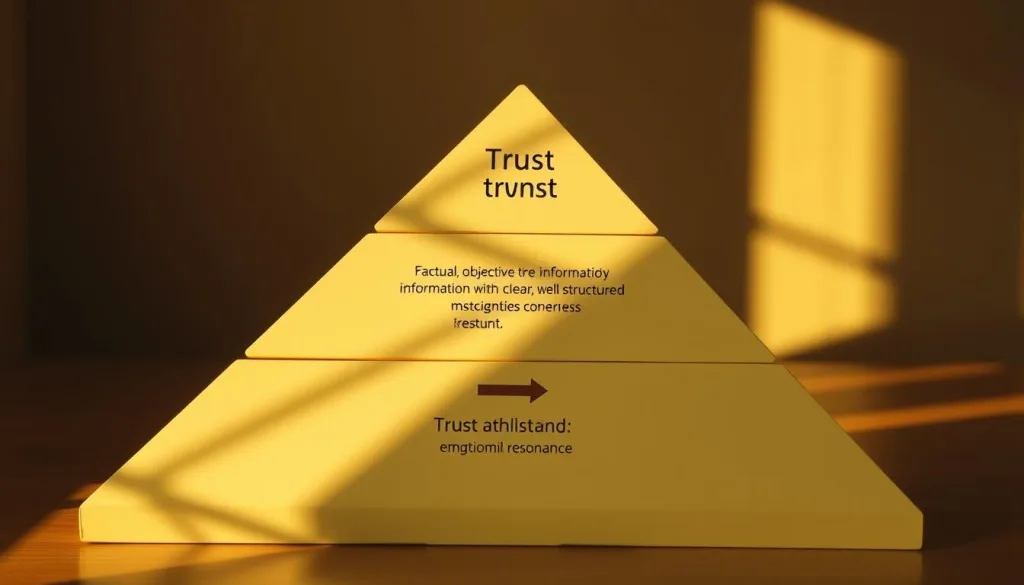How to Write Web Content That Builds Trust
In today’s digital world, creating website content is key to connecting with people online. Users want real, reliable info that meets their needs. Good web content does more than just share facts—it builds a real connection with visitors, turning them into loyal customers.
The Nielsen Norman Group found that trust grows over time through good interactions. To make SEO-friendly content, you need to understand how users feel when they look at online info. Every digital piece is a chance to show you’re credible and know your stuff.
Today’s online shoppers are smart and can tell the difference between fake and real content. Your web content should solve problems, be clear, and show you care. By focusing on user experience and quality info, you can make a real connection with your audience.
Building trust online is all about creating a strong bond. Web content that truly understands and connects with users will lead to stronger trust and better results.
Understanding the Pyramid of Trust in Web Content

Creating great website content needs a smart plan to win over online readers. The trust pyramid is key for making engaging content that reaches people on different levels.
Trust isn’t just one thing; it’s made up of many parts that grow together. Businesses must know how to move through each level of the pyramid to really connect with their audience.
Establishing Baseline Relevance and Credibility
The base of trust is about giving accurate, relevant info. Readers check if the content meets their needs and solves their problems. This means:
- Providing clear, precise information
- Demonstrating subject matter expertise
- Using verifiable data and sources
- Addressing specific user concerns
Building Interest and Preference
After establishing credibility, content must stand out. Unique value propositions are key to turning initial interest into real preference. This involves:
- Distinctive problem-solving approaches
- Innovative perspectives on industry challenges
- Compelling storytelling
- Authentic brand personality
Developing Long-term Relationship Trust
The top of the trust pyramid is about creating consistent, open content that shows you care about users’ success. Great website content should grow from just giving info to building real relationships, focusing on long-term value and true support for users.
Website Content Creation Strategies for Trustworthy Brands
To build trust, content marketing needs a smart plan. It’s not just about promoting. Today, professional website writing must offer real value to connect with people.

Great brands know how to make a real bond with their audience. They share content that teaches, informs, and adds real value.
Creating Educational Over Promotional Content
People want to learn, not just be sold to. Good content marketing focuses on:
- Sharing deep industry insights
- Fixing real customer issues
- Offering practical tips
- Showcasing true expertise
Incorporating Social Proof and Testimonials
Trust grows with solid proof. Professional writing should include:
- Stories of customer success
- Endorsements from experts
- Real testimonials from clients
- Clear results and case studies
Maintaining Content Consistency and Quality
Being reliable means keeping a consistent voice and high standards online. This way, every interaction with your brand feels trustworthy.
The goal is to turn content into something valuable that truly speaks to your audience.
Demonstrating Expertise Through High-Quality Content
Creating top-notch content is key for any content agency wanting to be seen as credible online. The digital world needs more than just basic info. Businesses must craft content that shows their true expertise and adds real value to readers.
Great SEO-friendly content is more than just using the right keywords. It’s about really understanding what your audience needs and giving them insights that help them.
- Develop in-depth industry guides
- Create detailed research reports
- Produce educational video series
- Design interactive content resources
Today’s consumers want real, knowledgeable content that answers their specific questions. A winning content strategy includes:
| Content Type | Purpose | Key Benefit |
|---|---|---|
| Whitepapers | Deep Industry Analysis | Establishes Thought Leadership |
| Expert Blog Posts | Practical Insights | Builds Audience Trust |
| Case Studies | Real-World Problem Solving | Demonstrates Practical Expertise |
By always sharing high-quality, informative content, brands can become leaders in their field. They can also build strong connections with their audience.
Transparency and Authenticity in Web Writing
Digital audiences want real connections with brands. Good website copy is honest, not just flashy. Web content strategies that are open build trust with customers.
Today’s consumers are smart. They spot marketing tricks fast. Brands that talk openly build stronger bonds with their audience.
Addressing Customer Pain Points Directly
Good web writing faces customer challenges head-on. Instead of dodging tough topics, top brands:
- Identify specific customer issues
- Show empathy with clear words
- Offer real solutions
Providing Clear Value Propositions
Web content should be simple, not complicated. Share your unique value clearly and fast. Visitors should get your point in seconds.
Being Upfront About Product Limitations
Talking about what your product can’t do can actually make you more credible. Customers value brands that:
- Set realistic expectations
- Show off their true strengths
- Stay honest in their words
Studies show 70% of people dislike content that’s too focused on sales. Being open can turn doubt into trust.
Conclusion
Creating effective website content is more than just writing. It’s about making a story that connects with people. This content is key to building trust and turning visitors into loyal customers.
Building trust takes time. Businesses need to keep delivering valuable, real content that meets user needs. By doing this, they can make their online presence stand out.
Creating trust is an ongoing effort. It’s not just about writing once and then stopping. It’s about always understanding your audience and showing real value. Brands that focus on trust will see better engagement and success online.
Building trust through web content takes patience and honesty. It’s about serving your audience’s needs. By doing this, businesses can create websites that inform and connect with people in a real way.







